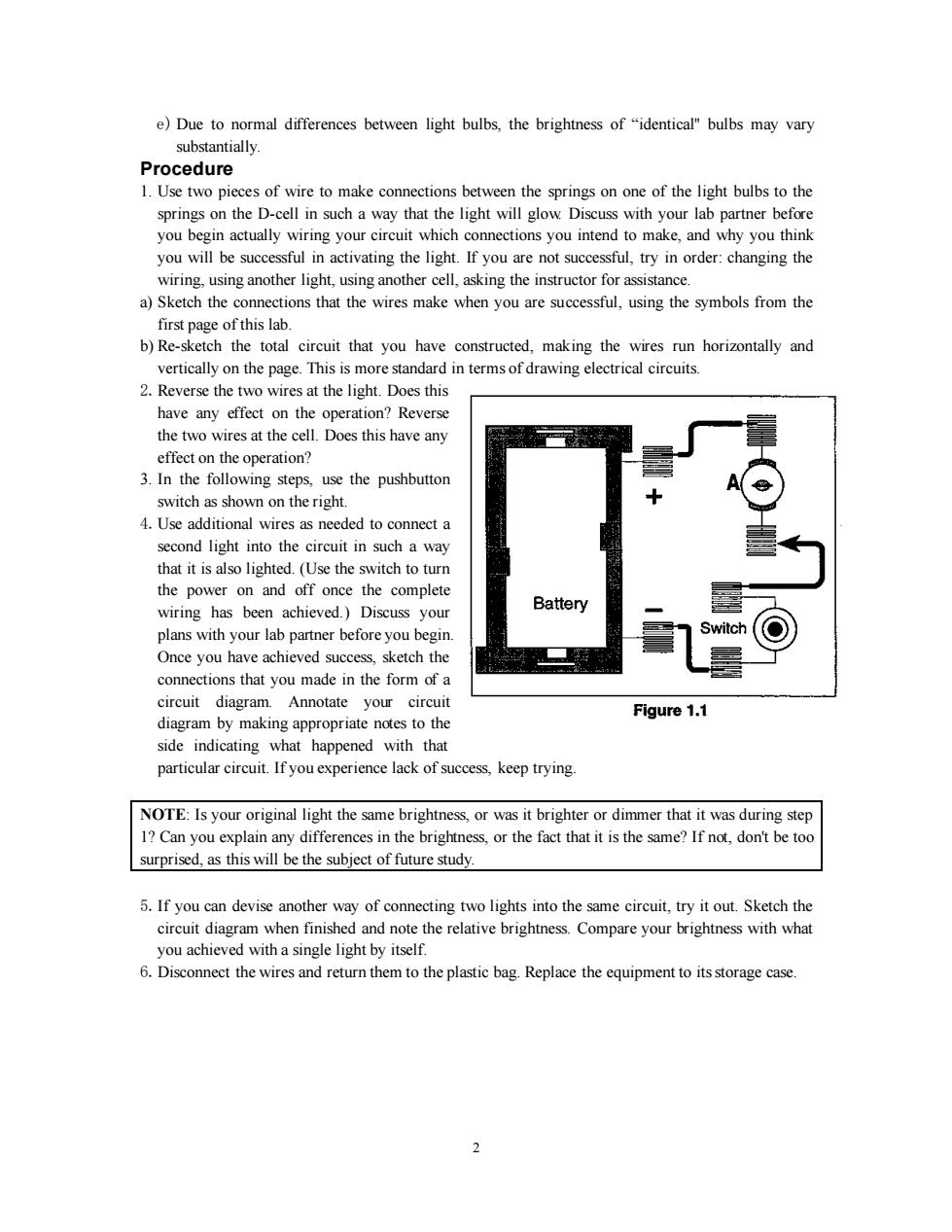正在加载图片...

e)Due to normal differences between light bulbs,the brightness of"identical"bulbs may vary substantially. Procedure 1.Use two pieces of wire to make connections between the springs on one of the light bulbs to the springs on the D-cell in such a way that the light will glow Discuss with your lab partner before you begin actually wiring your circuit which connections you intend to make,and why you think you will be successful in activating the light.If you are not successful,try in order:changing the wiring,using another light,using another cell,asking the instructor for assistance. a)Sketch the connections that the wires make when you are successful,using the symbols from the first page of this lab. b)Re-sketch the total circuit that you have constructed,making the wires run horizontally and vertically on the page.This is more standard in terms of drawing electrical circuits. 2.Reverse the two wires at the light.Does this have any effect on the operation?Reverse the two wires at the cell.Does this have any effect on the operation? 3.In the following steps,use the pushbutton switch as shown on the right. 4.Use additional wires as needed to connect a second light into the circuit in such a way that it is also lighted.(Use the switch to turn the power on and off once the complete wiring has been achieved.)Discuss your Battery plans with your lab partner before you begin. Switch Once you have achieved success,sketch the connections that you made in the form of a circuit diagram.Annotate your circuit Figure 1.1 diagram by making appropriate notes to the side indicating what happened with that particular circuit.If you experience lack of success,keep trying. NOTE:Is your original light the same brightness,or was it brighter or dimmer that it was during step 1?Can you explain any differences in the brightness,or the fact that it is the same?If not,don't be too surprised,as this will be the subject of future study. 5.If you can devise another way of connecting two lights into the same circuit,try it out.Sketch the circuit diagram when finished and note the relative brightness.Compare your brightness with what you achieved with a single light by itself. 6.Disconnect the wires and return them to the plastic bag.Replace the equipment to its storage case. 22 e) Due to normal differences between light bulbs, the brightness of “identical'' bulbs may vary substantially. Procedure 1. Use two pieces of wire to make connections between the springs on one of the light bulbs to the springs on the D-cell in such a way that the light will glow. Discuss with your lab partner before you begin actually wiring your circuit which connections you intend to make, and why you think you will be successful in activating the light. If you are not successful, try in order: changing the wiring, using another light, using another cell, asking the instructor for assistance. a) Sketch the connections that the wires make when you are successful, using the symbols from the first page of this lab. b) Re-sketch the total circuit that you have constructed, making the wires run horizontally and vertically on the page. This is more standard in terms of drawing electrical circuits. 2.Reverse the two wires at the light. Does this have any effect on the operation? Reverse the two wires at the cell. Does this have any effect on the operation? 3. In the following steps, use the pushbutton switch as shown on the right. 4.Use additional wires as needed to connect a second light into the circuit in such a way that it is also lighted. (Use the switch to turn the power on and off once the complete wiring has been achieved.) Discuss your plans with your lab partner before you begin. Once you have achieved success, sketch the connections that you made in the form of a circuit diagram. Annotate your circuit diagram by making appropriate notes to the side indicating what happened with that particular circuit. If you experience lack of success, keep trying. NOTE: Is your original light the same brightness, or was it brighter or dimmer that it was during step 1? Can you explain any differences in the brightness, or the fact that it is the same? If not, don't be too surprised, as this will be the subject of future study. 5.If you can devise another way of connecting two lights into the same circuit, try it out. Sketch the circuit diagram when finished and note the relative brightness. Compare your brightness with what you achieved with a single light by itself. 6.Disconnect the wires and return them to the plastic bag. Replace the equipment to its storage case